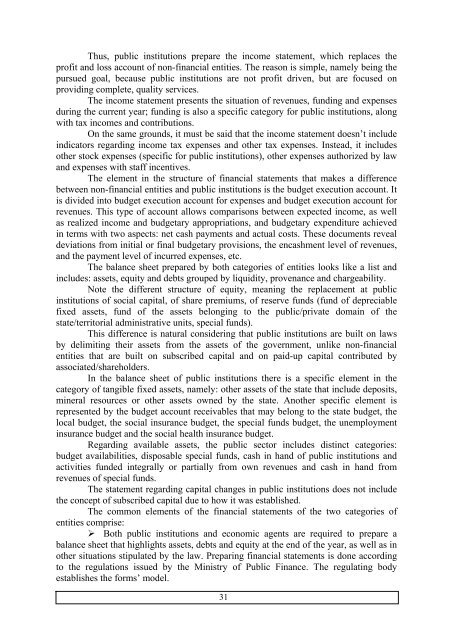Revista Tinerilor Economiºti (The Young Economists Journal)
Revista Tinerilor Economiºti (The Young Economists Journal)
Revista Tinerilor Economiºti (The Young Economists Journal)
Create successful ePaper yourself
Turn your PDF publications into a flip-book with our unique Google optimized e-Paper software.
Thus, public institutions prepare the income statement, which replaces the<br />
profit and loss account of non-financial entities. <strong>The</strong> reason is simple, namely being the<br />
pursued goal, because public institutions are not profit driven, but are focused on<br />
providing complete, quality services.<br />
<strong>The</strong> income statement presents the situation of revenues, funding and expenses<br />
during the current year; funding is also a specific category for public institutions, along<br />
with tax incomes and contributions.<br />
On the same grounds, it must be said that the income statement doesn’t include<br />
indicators regarding income tax expenses and other tax expenses. Instead, it includes<br />
other stock expenses (specific for public institutions), other expenses authorized by law<br />
and expenses with staff incentives.<br />
<strong>The</strong> element in the structure of financial statements that makes a difference<br />
between non-financial entities and public institutions is the budget execution account. It<br />
is divided into budget execution account for expenses and budget execution account for<br />
revenues. This type of account allows comparisons between expected income, as well<br />
as realized income and budgetary appropriations, and budgetary expenditure achieved<br />
in terms with two aspects: net cash payments and actual costs. <strong>The</strong>se documents reveal<br />
deviations from initial or final budgetary provisions, the encashment level of revenues,<br />
and the payment level of incurred expenses, etc.<br />
<strong>The</strong> balance sheet prepared by both categories of entities looks like a list and<br />
includes: assets, equity and debts grouped by liquidity, provenance and chargeability.<br />
Note the different structure of equity, meaning the replacement at public<br />
institutions of social capital, of share premiums, of reserve funds (fund of depreciable<br />
fixed assets, fund of the assets belonging to the public/private domain of the<br />
state/territorial administrative units, special funds).<br />
This difference is natural considering that public institutions are built on laws<br />
by delimiting their assets from the assets of the government, unlike non-financial<br />
entities that are built on subscribed capital and on paid-up capital contributed by<br />
associated/shareholders.<br />
In the balance sheet of public institutions there is a specific element in the<br />
category of tangible fixed assets, namely: other assets of the state that include deposits,<br />
mineral resources or other assets owned by the state. Another specific element is<br />
represented by the budget account receivables that may belong to the state budget, the<br />
local budget, the social insurance budget, the special funds budget, the unemployment<br />
insurance budget and the social health insurance budget.<br />
Regarding available assets, the public sector includes distinct categories:<br />
budget availabilities, disposable special funds, cash in hand of public institutions and<br />
activities funded integrally or partially from own revenues and cash in hand from<br />
revenues of special funds.<br />
<strong>The</strong> statement regarding capital changes in public institutions does not include<br />
the concept of subscribed capital due to how it was established.<br />
<strong>The</strong> common elements of the financial statements of the two categories of<br />
entities comprise:<br />
� Both public institutions and economic agents are required to prepare a<br />
balance sheet that highlights assets, debts and equity at the end of the year, as well as in<br />
other situations stipulated by the law. Preparing financial statements is done according<br />
to the regulations issued by the Ministry of Public Finance. <strong>The</strong> regulating body<br />
establishes the forms’ model.<br />
31















